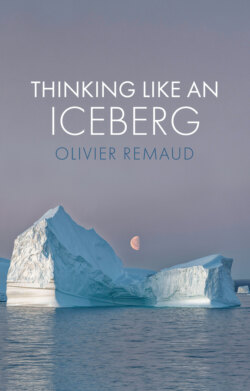Читать книгу Thinking Like an Iceberg - Olivier Remaud - Страница 14
A story about skulls
ОглавлениеThe young Arthur Conan Doyle is in his third year of medical school in Edinburgh. For a taste of adventure, he breaks off his studies and embarks for a few months on the whaling ship Hope. From February to August 1880, he sails between Greenland, the Faroe Islands and Spitsbergen. He is horrified to discover what the whale hunters did. He describes the thick fogs, and several times he falls into the cold waters. Luckily, he escapes. The experience leaves its mark. In his diary, he writes about the ‘other-world feeling’ that he experienced from the very first moments, and which never left him. This other-worldly feeling haunted him with the power of an obsession.16 The budding writer did not return unscathed from his journey beyond the Arctic Circle.
In polar environments, perhaps more than anywhere else, metaphors are used as a means of orientation in an uncertain context. The captains use them, of course, to decorate the notes in their logbooks. But deep down they know that they are lifelines that help sailors to keep their minds on the job. The eye does not capture everything in front of icebergs drifting in the ocean. Such volumes seem immovable. Yet they are versatile and fleeting. Icebergs weaken the consciousness as soon as they appear. They thwart one’s intentions because they do not correspond to objects that are easy to identify. The philosopher Hans Blumenberg writes that, in everyday life, metaphor generally expresses ‘the need to incorporate, as part of the total causal system, even the most surprising event, bordering on a supposed “miracle”.’17
An iceberg emerging from the mist has all the features of a miracle.
It is inexplicable: how can one describe it? The appearance of a mass on the water, the memory of the moment when it broke away from a glacier, its immense dimensions, the fear of a collision, all these elements ‘disturb’ one’s habits. The mind feels the need to find clearer and more stable meanings. It must be able to fill its confusion. Metaphors help it to rationalise its ‘situation of need’.18 They domesticate the feeling of ‘the uncanny’, as Sigmund Freud put it, that icebergs inspire. They tame the irrational part of the sublime feeling, when nature is frightening. Their role is to re-establish, as far as possible, an unequivocal, or at least a more reassuring, order of understanding. For this reason, the iceberg gives rise to many metaphors. It also becomes the ideal partner for inner conversations. Everyone recognises their own image in it. On the condition that we admit its finitude. But in what way exactly?
Walter Benjamin closely studied the use of allegory in Baroque drama. He interprets this figure as the language of the creature separated from its origin by the original sin. No transcendence governs its existence any more. No salvation is possible. Everything is frozen. With the allegory, history itself becomes crystallised. The ‘observer is confronted with . . . a petrified primordial landscape.’19 In the history of art, baroque allegories do not present themselves with harmonious lines, as symbols of eternity. They show skulls. The skull is the face of time.
The polar romantic spirit extends and interprets the content of baroque allegory in its own way. An iceberg floating alone carries the spleen of the fragile human condition. In the nineteenth century, many explorers and less adventurous travellers internalised this feeling. Their metaphors reflect this. Icebergs become gigantic skulls. For the fallen conquerors, these blocks are princely figures in an archaic setting. They illustrate the vanity of mankind, like personal tombs that anticipate a collective disaster. They themselves are destined to be destroyed and are glaciers in mourning. They bear witness to the glacier’s slow death. As they calve, the fragments reveal the meaning of the whole. They express the evolution of a world on the threshold of catastrophe.
In the end, icebergs are fascinating because they embody a series of insoluble paradoxes. They give rise to hope as much as to despair. Their solid forms say, first of all, that they will last. They arouse a desire for permanence. Then they erode, showing that they are destined to fall apart. The block is ephemeral. On the one hand, it sculpts itself, changing its appearance in a short time. Its ability to reinvent itself is captivating. On the other hand, it reminds us of the fleeting nature of existence, impeding any real consolation.
The romantic spirit is sometimes euphoric, sometimes inconsolable. It combines exaltation and sadness, the passion for the grandiose and the allegorically natural. It admires monumental nature and contemplates death. It always sees icebergs as something other than what they are: contours and proportions that evoke familiar faces, animal profiles, the silhouettes of buildings, or even skulls. In the middle of the polar oceans, everyone interprets their morphological diversity through the prism of their desires or concerns. Sometimes they know that the causes of their changing aesthetics lie elsewhere: winds, currents, collisions, warm waters. Perhaps they even suspect that without ice there would be no humanity, or any other life.
But icebergs capture all the metaphors and reflect them back without absorbing them. They are the mirrors of personal histories as much as of myths of conquest. They exacerbate the constantly self-reflective sensibility of the Moderns.20 The aesthetics of the sublime is an aesthetics of humans who speak to other humans.
